Innovations: Visions for the future
Predictions for AOPA’s 100th anniversary and beyond

 Eric Allison: Highways in the sky
Eric Allison: Highways in the sky
Uber thinks eVTOL will be part of your commute
By Jill W. Tallman
If you’re thinking you can walk out of a bar and summon a drone to fly you home, that’s not quite on the mark. But Uber thinks electric vertical takeoff and landing (eVTOL) aircraft will be a part of your commute—and it could be as soon as 2023.
Eric Allison, head of Uber Elevate, said the company wants to put fleets of eVTOL in major cities that would whisk passengers from point to point as part of a larger rideshare network that, ideally, would incorporate Uber cars and possibly scooters and motorcycles.
But don’t expect to have to tramp out to an airport as part of this commute. Uber Elevate is looking at utilizing existing infrastructure, such as the top floors of parking garages, as departure and arrival points for eVTOL aircraft. As ridesharing becomes more prevalent and people become less dependent on cars, parking garages will become somewhat of an underutilized asset, Allison said. And the fact that eVTOLs will require charging ports but not liquid fuel changes the safety requirements and minimizes the complexity of putting in skyports and infrastructure, Allison said.
Initially, the vehicles would be flown by pilots utilizing existing routes, such as VFR corridors through controlled airspace and helicopter routes. As the rideshare system is developed, more advanced types of routes would come online, Allison said.
“Our vision is that they will start piloted and we think they’ll be piloted for quite some time,” he said. “Then I think there’ll be an interesting opportunity for a new type of career for pilots who want to fly these vehicles because these networks will be fairly compact over a single urban area. It’ll mean staying local and operating in one of these networks in a metropolitan area.”
There’d be no storage or maintenance of eVTOLs on these parking deck rooftops. Uber Elevate is still evaluating where maintenance should take place, but anticipates partnering with companies—including “nontraditional” organizations—to perform routine or unusual maintenance.
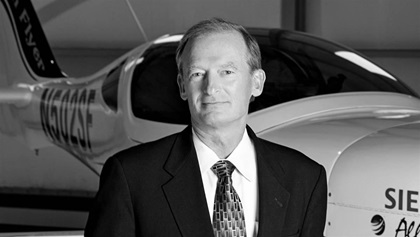 George Bye: Charging the future
George Bye: Charging the future
More powerful batteries are coming soon
By Thomas A. Horne
George Bye, CEO of Englewood, Colorado’s Bye Aerospace, heads up the electrically powered eFlyer 2 and eFlyer 4 two- and four-seater projects, respectively. So it comes as no surprise that Bye thinks general aviation’s future lies with electrical power. “In 20 years, electrically powered aircraft will be commonplace, electrically powered cars will be commonplace, battery energy density issues will be solved, and any problems with charging stations will be solved,” he said.
“Big changes are underway right now. The current lithium-ion battery chemistry will be replaced by solid state technology, and this and other improvements will bring higher energy density....Soon, we’ll see 25- to 50-percent increases in battery energy per unit of weight. In fact, between 2012 and 2019, battery energy densities as they apply to general aviation aircraft have more than doubled. By 2040, I fully expect battery energy densities for general aviation aircraft to be four times where they are today.”
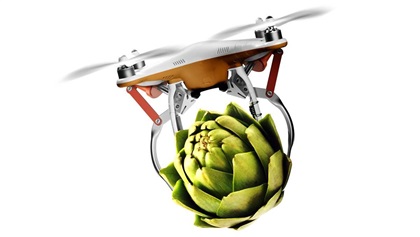 “Hybrid propulsion systems [those that pair internal combustion engines with battery power] will play a role in the interim, but these systems are complex. They’re doable, but in 20 years we should have all-electric designs with similarities to, say, a Beech Bonanza in terms of speed, range, endurance, and load-carrying ability,” Bye said.
“Hybrid propulsion systems [those that pair internal combustion engines with battery power] will play a role in the interim, but these systems are complex. They’re doable, but in 20 years we should have all-electric designs with similarities to, say, a Beech Bonanza in terms of speed, range, endurance, and load-carrying ability,” Bye said.
He’s not as sanguine about eVTOL technology’s future. “Their ducted fans are only efficient in the vertical phase of flight, but they create a lot of noise, and weigh a lot, and create a lot of drag in horizontal flight,” he said. “Also, their many design concepts—with some having articulating wings and multiple engines—have yet to be proven. As with helicopter technology, eVTOLs may eventually become practical, but it will take time.”
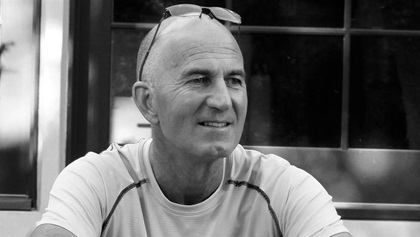 Dave Vos: The missing ingredient
Dave Vos: The missing ingredient
The culture shift necessary to develop next-generation urban travel
By Thomas B. Haines
Drones, urban air transports, eVTOL—whatever you call the next-generation vehicles that will supposedly whisk urban dwellers around a metropolitan region—face many challenges, but it may not be the challenges you think. The electric motors, the batteries, and the technology to control such aircraft exist today. Sure, improvements must be made to increase performance, especially with batteries. But the real challenge, according to technology expert Dave Vos, is the ability—or willingness—of software developers to quickly learn what the aviation and aerospace industry has struggled with for more than 100 years—demanding a level of reliability and redundancy that is safe right out of the box.
“The tech world has so much to learn about safety and reliability. The culture that you have a solid review process—that’s missing,” said Vos. “Yes, you need to be efficient and nimble, but there is no substitute for the disciplined process that aviation and even bridge and tunnel designers have used for years. There’s really only going to be one winner, and that is safety. You can’t just hit the compile button and go try something, and figure you’ll fix the problems later, when you’re dealing with people’s lives.”
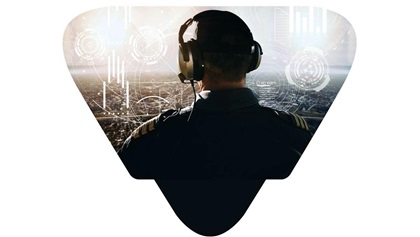 Vos is the co-founder of Athena Technologies, a Virginia company that developed flight control systems for large military drones. After selling that company to Rockwell Collins, he moved to Google to run its Project Wing program—the outfit that used drones to deliver 1,000 Chipotle burritos to students on the campus of Virginia Tech. He has since left the tech world to run his horse business.
Vos is the co-founder of Athena Technologies, a Virginia company that developed flight control systems for large military drones. After selling that company to Rockwell Collins, he moved to Google to run its Project Wing program—the outfit that used drones to deliver 1,000 Chipotle burritos to students on the campus of Virginia Tech. He has since left the tech world to run his horse business.
If the software developers can make the culture leap, Vos believes that drones will get full certification for delivery purposes within the next five years, which will be a watershed moment for future passenger operations. Delivery operations will give air traffic control, manufacturers, and regulators a chance to understand fleet operations, which will lead to more acceptance of the notion of passenger-carrying flights, he said.
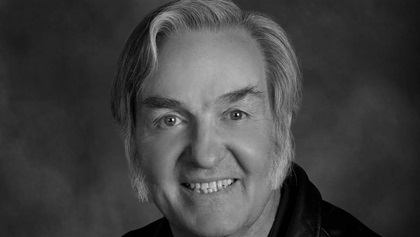 Burt Rutan: Yesterday, today, and tomorrow
Burt Rutan: Yesterday, today, and tomorrow
Innovations that never came
By Dave Hirschman
Burt Rutan regards the last few decades of general aviation development as “pretty damn disappointing.”
His wife’s 1965 Piper Cherokee 180 is more than a half-century old, yet its speed, fuel economy, and engine technology are comparable to current GA aircraft—and he says that shows a pitiful lack of innovation.
In the late 1990s, Rutan thought GA was on the cusp of major advancements. Jet engine pioneer Sam Williams planned a family of low-cost, high-efficiency turbine engines, and Toyota had certified a liquid-cooled aircraft engine and flight tested it in a fast, efficient, and quiet four-seat aircraft.
 “I thought there would be competition that would drive costs down to an absolute minimum and push speed to the technological maximum,” he said. “I’m just shocked that somebody didn’t take the research that had already been done and build a modern general aviation airplane.”
“I thought there would be competition that would drive costs down to an absolute minimum and push speed to the technological maximum,” he said. “I’m just shocked that somebody didn’t take the research that had already been done and build a modern general aviation airplane.”
Neither the Williams small engines nor Toyota engines ever went into production, and the airplane Rutan considered his very best work in GA—the Boomerang—was rejected by investors who considered it too radical for the commercial market. Rutan, 75, said he’s still hopeful someone will recognize the asymmetrical design’s inherent safety benefits.
“When you have a breakthrough, before it’s seen as a breakthrough it’s regarded as nonsense,” he said. “People look at [the Boomerang] and consider it nonsense. But it could be the safest general aviation airplane, by far.”
Rutan is currently working on his forty-seventh research airplane, the one-off SkiGull, an ultra-long-range, two-seat, Rotax-powered amphibian he’s making “to explore the world.”
“It’s been a lot more difficult to develop than I thought it would be,” he said. “By the end of the summer I’ll know whether it’s been successful.”
 Barrington Irving: Changing the face of flying
Barrington Irving: Changing the face of flying
Tomorrow’s pilots will look different from today’s
By Ian J. Twombly
Let’s face facts. For the past 80 years, pilots in the United States have been primarily male and primarily white. The future recreational pilots, professional pilots, maintainers, engineers, and other associated professionals must come from a much wider demographic and socioeconomic cross-section.
Barrington Irving flew solo around the world when he was only 23; he says at that time it made him the youngest person ever to accomplish the feat and the first African American. Today he nurtures future aviation professionals through a nationwide STEM (science, technology, engineering, and math) curriculum and by speaking to kids about how aviation can enhance their future. “We have the greatest playground on Earth,” he said. “The people are there to be recruited.” Irving thinks future maintainers will come from automotive and marine backgrounds, and that for aviation to thrive, it needs to be a regular subject in the classroom. “Look at coding. It’s become a mainstay in the classroom. We’re going to need to take a similar approach. No more after-school programs, we need to be in the classroom.”
Those classrooms need to be in rich private schools as well as struggling inner city schools, as Irving’s was. He said one of the ironies of the challenge is that many airports are located in minority neighborhoods, just as his was. He was able to succeed because of a chance meeting with an airline pilot, an experience he’s hoping to pass on to the next generation.
 Jeff Haussmann: The HUD of 2039
Jeff Haussmann: The HUD of 2039
Ideally, no HUD at all
By Thomas A. Horne
What changes could we expect from 20 years of head-up display technology advancement? According to Jeff Hausmann, director, Advanced Flight Deck at Gulfstream Aerospace Corporation, some technology trends are clear and longstanding, namely higher-performance and lower-cost computer processing, but others are more recent, such as shorter product cycles and the growing capabilities of artificial intelligence. “We believe technology trends and user preferences will manifest themselves in three key areas: smaller, lighter HUDs with larger fields of view and higher resolutions; enhanced customization of displays to better suit mission demands and user preferences; and finally, the ultimate in HUD technology: HUD on a windscreen,” Hausmann said.
“The first HUD trend will be enabled by faster processors and improved optics,” he added. “These should support a larger field of view with more compact optics to minimize any intrusions into the pilot’s personal space. We also expect these advancements to reduce the cost of HUDs, allowing their deployment into more flight decks, including general aviation aircraft.”
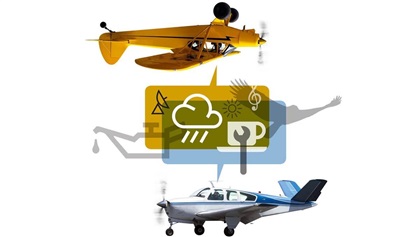 Hausmann said that processor and optics improvements will grow to support enhanced display customization. “For example, Gulfstream strongly believes in reducing crew workload by organizing information by phase of flight, using touchscreen controllers like those in our G500 and G600 Symmetry Flight Deck. Organizing information displayed on the HUD by phase of flight allows tailoring the display—without requiring repeated crew interaction with HUD controls,” he said.
Hausmann said that processor and optics improvements will grow to support enhanced display customization. “For example, Gulfstream strongly believes in reducing crew workload by organizing information by phase of flight, using touchscreen controllers like those in our G500 and G600 Symmetry Flight Deck. Organizing information displayed on the HUD by phase of flight allows tailoring the display—without requiring repeated crew interaction with HUD controls,” he said.
“Future HUDs will also support the display of multiple advanced sensors beyond today’s infrared-based camera systems, but this will require automation to maintain crew workload at an acceptable level. Finally, customization capabilities will also link with the broader goal for the aircraft to ‘know’ a pilot’s personal preferences and automatically tailor displays to show them. All this customization and information integration will likely be powered by advanced artificial intelligence that will anticipate or respond to the crew’s information needs and push the desired information their way automatically.”
Where is all this customization and automation going? Hausmann senses that “The ultimate in HUD technology is really no HUD at all. Current HUDs require a piece of glass in relatively close proximity to the pilot’s eyes to display the HUD’s symbology. Projecting the HUD symbology directly on the forward windscreen would enhance pilot comfort by eliminating the psychological impact of a HUD combiner so close to the pilot’s eyes. However, the challenges of putting HUD symbology directly on the windscreen involve bending a few rules of physics. Compared to everything else I discussed here, this will likely be the most difficult to achieve.”
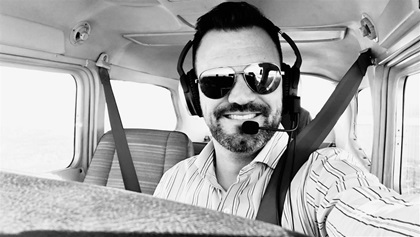 Brice Van Baren: Human factor
Brice Van Baren: Human factor
People—not tech—are the backbone of GA
By Jim Moore
While some of aviation’s big-name companies are betting that urban mobility will require autopilots on steroids, and designing eVTOL aircraft without flight controls, Flights Above the Pacific Northwest founder Brice Van Baren isn’t buying that.
“I don’t think that the human factor will be taken away in any way, shape, or form,” Van Baren said. While he fully expects new technology like augmented reality and advancements in devices like current-generation autopilots that provide envelope protection, Van Baren is convinced that it will take more than 20 years to convince the general aviation community to leave the flying to Mr. Robot.
“People are going to get more connected, going to fly together.”Flights Above the Pacific Northwest has grown into a national Facebook group, and, perhaps unsurprisingly, Van Baren expects the social aspect of general aviation will be more important than ever by 2039.
“People are going to get more connected, going to fly together,” Van Baren said. “We’re going to be able to communicate between airplanes with our devices.”
Augmented and virtual reality will enhance training and assist pilots, and Van Baren expects commercial aviation may well become less human-centric in the cockpit, but GA is going to be all about people. As long, he adds, as it doesn’t get too expensive. “The key to success and survival of general aviation is exactly that, is the price,” he said.
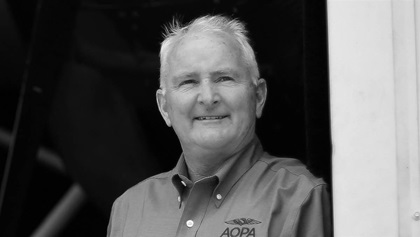 Mark Baker: A new golden age
Mark Baker: A new golden age
Future looking bright for general aviation
By Joe Kildea
AOPA President and CEO Mark Baker believes that general aviation is on the cusp of a second golden age. “General aviation has never been safer and flight hours, along with number of new student pilots beginning training, are both on the rise again—there’s never been a better time to be in this industry,” he said.
This turnaround sits against the backdrop of booming demand for workers with aviation skills and emerging technology that could revolutionize how we think of air travel. According to Boeing, there will be a global demand for 790,000 pilots over 20 years, 206,000 in North America alone.
“We have the greatest playground on Earth. The people are there to be recruited.”Baker also noted that with emerging eVTOL technology, flying will likely be cleaner, quieter, and more accessible than ever before. “We are already flying more, but in the near future even more people will be able to use general aviation and local airports to get where they are going with eVTOL technology,” said Baker
And with this growth and opportunity, Baker believes AOPA’s role has never been more important. He said, “AOPA’s mission of preserving the freedom to fly has remained unchanged for 80 years, and we need to make sure even more people in the next generation can experience the joy of flight and coming economic boom.”
“There’s never been a better time to be in this industry.”


